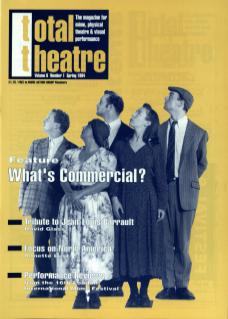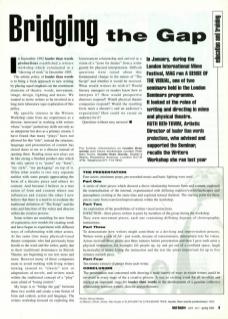In September 1992 louder than words productions established a writers workshop which culminated in a ‘showing of work’ in December 1993. The artistic policy of louder than words is to bring a fresh approach to new writing by placing equal emphasis on the constituent elements of theatre: words, movement, image, design, lighting and music. We wanted to invite writers to be involved in a long-term laboratory-type exploration of this policy.
My specific interest in the Writers Workshop came from my experiences as a director, interested in working with writers whose ‘scripts’ pushed my skills not only as an interpreter but also as a primary creator. I have found that many ‘plays’ have not allowed for this ‘role’; instead the structure, language and presentation of content has closed doors to me as a director instead of opening them. Reading many new plays can be like seeing a finished product onto which the only option is to ‘paste’ my ‘form’, ‘my style’, ‘my packaging’ on top of it. Often what results is two very separate entities with some people appreciating the form of a theatre piece and others its content. And because I believe in a true union of form and content where one influences and creates the other I now believe that there is a need to re-evaluate the traditional definition of ‘The Script’ and the roles and functions of the writer and director within the creative process.
Some writers are searching for new forms of expression, new models for creating work, and have begun to experiment with different ways of collaborating with other artists. At the same time many physical/visual theatre companies who had previously been hostile to the word and the writer, partly due to their traditional dominance in British Theatre, are beginning to use text more and more. However, many of these companies seem to avoid working with living writers turning instead to ‘classic’ texts or adaptations of novels, and writers stuck within the traditional concept of a ‘play’ seem afraid of ‘losing control’.
My hope is to ‘bridge the gap’ between these two worlds and create a true fusion of form and content, action and language. The writers workshop focused on exploring this form/content relationship and arrived at a vision of a ‘score for theatre’ from a writer geared for physical interpretation. Difficult questions were raised about this fundamental change in the nature of ‘The Script’ and whether it would be received. What would writers do with it? Would literary managers or readers know how to interpret it? How would prospective directors respond? Would physical theatre companies respond? Would the resulting form meet a theatre's and an audience's expectation? How could we create an audience for it?
Questions without easy answers!
The Presentation
Four actors, minimum props, pre-recorded music and basic lighting were used.
Part One
A series of short pieces which showed a direct relationship between form and content, explored the externalisation of the internal, experimented with differing realities/worlds/landscapes and atmospheres existing at the same time, and explored textual rhythms. The starting point for these pieces came from exercises/improvisations within the workshop.
Part Two
An exploration of the possibilities of written visual instructions. Infection – three pieces written in pairs by members of the group during the workshop. They were movement pieces, each one containing differing degrees of choreographic instructions.
Part Three
To demonstrate how writers might contribute to a devising and improvisation process, writers wrote a side of A4 – just words, streams of consciousness, atmospheric text for voices. Actors received these pieces just three minutes before presentation and then I gave each actor a physical instruction, for example: lift people up, try and get out of a confined space, laugh hysterically at times. Using the instruction and the text the actors improvised for up to five minutes on each piece.
Part Four
Ten minute extracts of pieces from each writer.
Conclusion
The presentation was concerned with showing a wide variety of ways in which writers could be involved in every stage of the creative process. It was an exciting event for all involved and marked an important stage for louder than words in the development of a genuine collective relationship between writers, director and performers.

